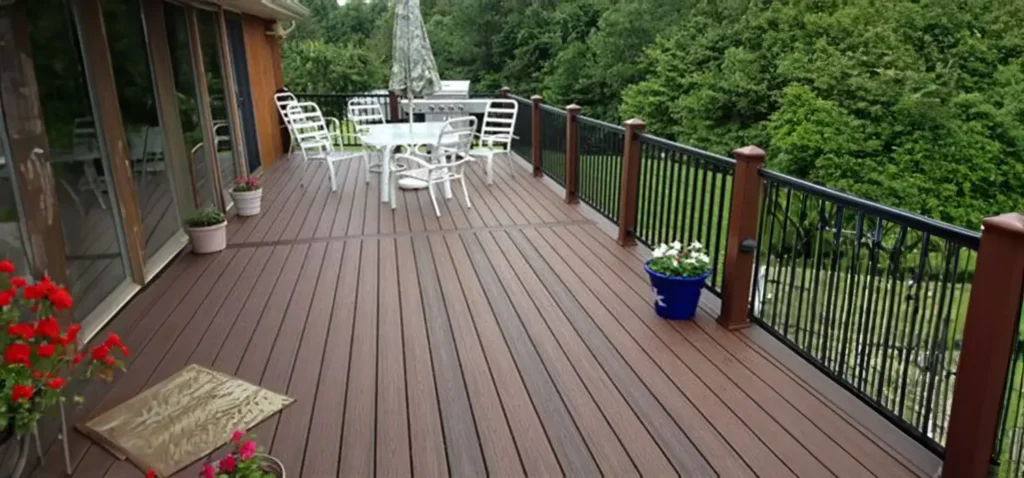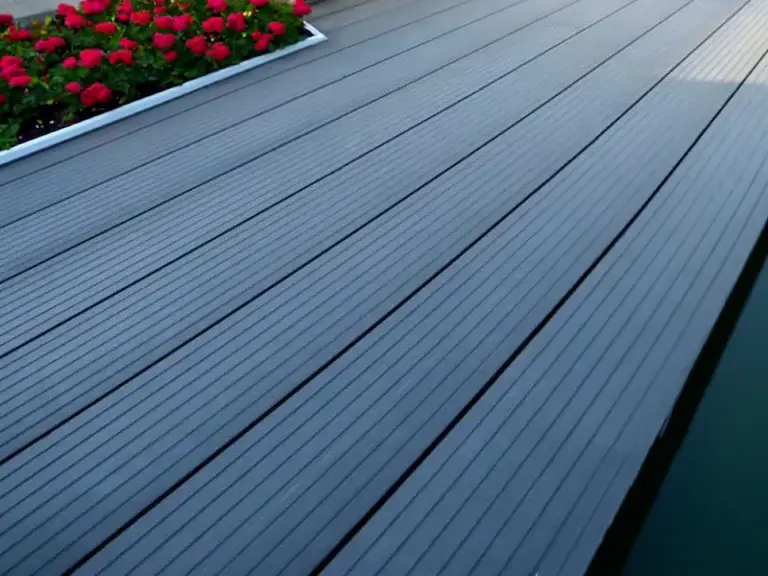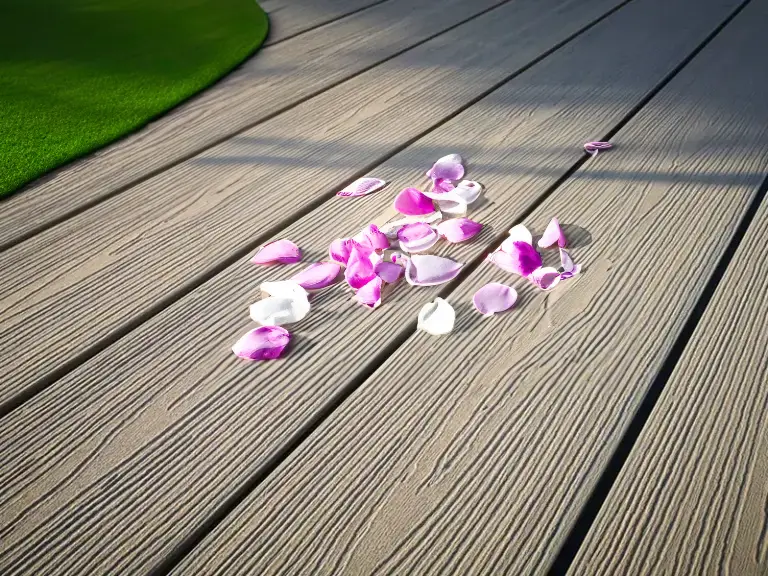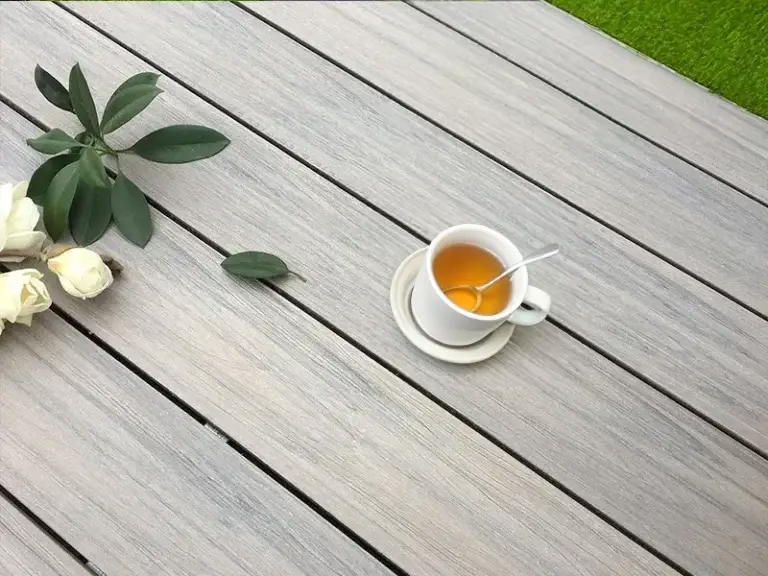Traditional Wood Decking
Traditional wood decks stand out for their natural beauty and timeless appeal when it comes to enhancing outdoor living spaces. With options ranging from robust hardwood decks to more economical softwood decks, homeowners and designers can choose the material that best suits their aesthetic preferences and practical needs. This essay delves into the characteristics, advantages, and disadvantages of both hardwood and softwood decks, providing insights into why they remain popular choices despite the emergence of alternative decking materials.
A. Hardwood Deck:
Hardwood decks are crafted from broadleaf trees, such as oak, maple, and mahogany, known for their dense wood grain and superior strength. These decks are highly prized for their durability and the natural beauty they bring to outdoor spaces.
Advantages:
- Durability: Hardwood decks boast a tight wood grain and high compressive strength, making them strong and capable of withstanding the test of time. Their resilience to wear and tear is a significant advantage for homeowners looking for long-lasting decking solutions.
- Aesthetic Appeal: Hardwoods’ complex and intricate wood grain patterns contribute to their popularity in high-end furniture and flooring applications. This natural beauty adds a touch of elegance and sophistication to any outdoor setting.
Cons:
- High Maintenance: Despite their durability, hardwood decks require regular maintenance to prevent issues such as rot and insect infestation. Tasks such as sanding, re-staining, and re-sealing are necessary to preserve the wood’s color and structural integrity.
- Cost: The rarity and superior properties of hardwoods translate into higher upfront and maintenance costs compared to other decking materials. This can be a limiting factor for some homeowners.
B. Softwood Deck:
Softwood decks are derived from coniferous or evergreen trees, including pine, cedar, and fir. These decks offer a more affordable alternative to hardwoods while still providing the natural beauty that wood is known for.
Pros:
- Cost-Effectiveness: The availability and lower cost of softwoods make them a popular choice for decking. They offer homeowners the opportunity to enjoy the aesthetic benefits of wood decks without the high price tag associated with hardwoods.
- Natural Beauty: Despite having a looser grain, softwood decks possess a natural charm and warmth that can enhance the appearance of any outdoor space.
Cons:
- Less Durability: Softwood decks are less dense and hard compared to hardwoods, making them less durable. This lower density means that softwood decks are more prone to damage and wear over time.
- High Maintenance: Similar to hardwood decks, softwood decks require significant maintenance to combat weathering and extend their lifespan. This includes more frequent staining, sealing, and potential replacement compared to more durable decking materials.
Pressure-treated wooden deck
When it comes to outdoor decking options, pressure-treated wood decking is a common option. This specially treated wood is designed to improve its durability in outdoor environments to meet people’s needs for long-term stable use.
During pressure treatment, preservatives are injected into the wood structure under high pressure. This allows the preservative to penetrate deeply and bond tightly with the wood fibers, giving the wood significant performance improvements.
The advantages are obvious, first of all in terms of cost. Pressure-treated wood decks are often more cost-effective than some naturally durable wood deck materials, such as redwood or cedar. For example, building a deck of the same size using redwood may cost tens of thousands of dollars, while pressure-treated lumber may cost half or less, making it an ideal choice for many consumers on a tight budget. Secondly, it performs well in terms of resistance. Due to the deep penetration of preservatives, pressure-treated wood decking has enhanced resistance to rot and insects, allowing it to remain in good condition for long periods of time in outdoor environments and resist the elements. For example, in humid and rainy areas, a regular wood deck may show signs of rot within a few years, but a pressure-treated wood deck will remain stable for many years.
However, there are two sides to everything, and pressure-treated wood decks are no exception. One significant disadvantage is its potential toxicity. Due to the use of chemical preservatives, this decking may contain some chemical residues, posing a potential risk to the environment and human health. For example, soil and water sources near decks may be contaminated to some extent. Furthermore, maintenance costs are also an issue that needs to be considered. Although pressure-treated wood decks are relatively more durable, they still require regular maintenance. For example, a waterproofing agent or protective coating needs to be applied every year to extend its service life, and each maintenance may cost hundreds of dollars. Moreover, treated wood is prone to fading and gradually turning gray under long-term exposure to sunlight, so it needs to be dyed or colored regularly to maintain its beautiful appearance. In areas with full sun, re-staining may be required every year or two.
Composite decking

Composite decking (WPC decking) is an innovative option in today’s building and outdoor decoration materials. Its unique composition makes it both beautiful and practical.
Advantages of composite decking
Low maintenance cost
Composite decking requires almost no regular staining, sealing or sanding, unlike the frequent and tedious maintenance of traditional wooden decks. This not only saves time and energy but also reduces long-term maintenance costs.
Excellent performance
It has excellent anti-fading properties, and its color remains stable regardless of long-term sunlight exposure. Its anti-warping and anti-cracking properties allow it to maintain its good shape in various extreme weather conditions, ensuring durability and stability in use.
Rich design options
A wide variety of colors and textures are available, providing designers and users with a wide range of creative space to meet different styles and personalized needs.
Disadvantages of composite decking
Higher initial cost
The initial acquisition cost of composite decking is significantly higher than that of traditional wooden flooring. This is because the materials such as recycled plastics and wood fibers used in its production process improve durability but also increase production costs.
Large price differences
Differences between brands and differences in features such as whether or not the flooring has a capping board will cause the price of laminate flooring to fluctuate significantly. This requires consumers to compare and evaluate more carefully when choosing.
PVC decking
PVC decks are becoming a popular choice for outdoor deck materials. They have unique materials and manufacturing processes that show distinctive characteristics.
Manufacturing process of PVC decks
PVC decks are usually made of polyvinyl chloride (PVC) resin as the main material. First, the resin is mixed with various additives to form a plastic compound. Then, it is molded into the shape of the deck by extrusion or pressing. Finally, according to actual needs, color, texture and protective layers are added to it to enhance durability and visual appeal.
Advantages
Excellent durability
PVC decks can effectively resist damage from moisture, mold and insects due to the characteristics of synthetic materials. They can remain in good condition in various harsh weather conditions and show excellent durability.
Easy maintenance
Due to the special nature of its material, it does not require complex maintenance work such as regular staining, sealing or painting. Simple cleaning with soap and water can easily maintain its good appearance and function, providing homeowners with a convenient and worry-free outdoor living space.
Disadvantages
High upfront costs
Despite its many advantages, PVC decking has a relatively high upfront cost due to the materials and complex manufacturing process involved, which may make some consumers hesitate when choosing it.
Environmental impact
The energy-intensive nature of its production process, the use of chemical additives, non-biodegradability and recycling challenges have raised a series of environmental issues and put some pressure on sustainable development.
How to Choose the Best Deck Material: A Comprehensive Decision-Making Guide
When planning the construction of an outdoor deck, choosing the right material is a critical step. Different deck materials have their own characteristics and advantages, and there are several key factors to consider to ensure that the final choice meets both practical needs and personal preferences.
Key Factors
Desired Look and Feel
Natural wood exudes a unique natural beauty that can add a warm and rustic atmosphere to outdoor spaces.
Synthetic materials such as composites or PVC show modern appeal and have a sleek, simple appearance.
Purpose and Location
If the deck is installed near water or in a humid climate, it is necessary to prioritize materials that are resistant to moisture and mildew to ensure long-term stability.
For example, in coastal areas, materials that are resistant to rot are more suitable, while in rainy mountainous areas, materials with strong water resistance are preferred.
Maintenance
Natural wood requires regular maintenance work such as staining, sealing and insect repellent treatment.
In contrast, composite and PVC decks are low-maintenance and usually require only simple cleaning and occasional inspections.
Budget
Hardwood decks are usually more expensive initially and have a higher maintenance cost later on.
Some more affordable materials, such as regular wood or some composite materials, may have lower upfront costs, but be aware that their performance and lifespan may be relatively shorter.



